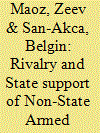| Srl | Item |
| 1 |
ID:
134938


|
|
|
|
|
| Summary/Abstract |
The research on the influence of democracy on terrorism renders support for two causal mechanisms. One is that democracy reduces terrorism because it creates an environment in which dissenters can pursue their interests through peaceful means. The other argument states that democracy encourages terrorism due to the intrinsic liberties and freedoms that provide an opportunity for terrorists to easily organize, recruit, and mount operations. This article contributes to this second line of thought by framing support for rebel groups as one of the contexts in which democracy’s influence on terrorism is examined. I identify a theoretical mechanism about how democratic states unknowingly facilitate terrorism by letting terrorists freely stay within their borders, raise funds, smuggle arms, and operate offices. The empirical findings provide support for the hypothesis that democracies are vulnerable and can easily be exploited by terrorists since they have an environment conducive to terrorist activities.
|
|
|
|
|
|
|
|
|
|
|
|
|
|
|
|
| 2 |
ID:
175191


|
|
|
|
|
| Summary/Abstract |
How does the anticipation of external support for both opposition groups and governments affect the likelihood and form (violent vs. nonviolent) of uprising within states? We develop a novel approach to address these issues, building on a network perspective. Our model suggests that both opposition groups and governments’ strategies are affected by an anticipation of the degree and nature of expected support by external parties (states and non-state actors). Using a set of indicators – including cultural affinity, strategic factors, and normative values – we develop a unique measure of anticipated support based on the potential support networks of target states and their opposition in order to evaluate our hypotheses. We argue that the anticipated balance of support for opposition and governments affects: (a) the likelihood of uprising and (b) the principal – violent or nonviolent – strategy used by the opposition group. We analyze data on violent and nonviolent civil conflicts over the period 1946–2010. We find that when the balance of anticipated support favors the opposition over their target government, the onset of an uprising is more likely. Specifically, the type of anticipated support has implications for whether a violent or nonviolent uprising occurs. These findings provide new insights into the role external support can play even before conflict occurs.
|
|
|
|
|
|
|
|
|
|
|
|
|
|
|
|
| 3 |
ID:
118173


|
|
|
|
|
| Publication |
2012.
|
| Summary/Abstract |
This study examines the conditions under which states engaged in strategic rivalries choose to support Non-state Armed Groups (NAGs) that target their rivals. NAGs include ethnic or religious insurgents, guerilla organizations, and terrorists. We develop a rational choice model of state support for NAGs. We focus on state support of NAGs as cooperation between states and NAGs emerging out of a mutual and purposive decision-making process. The model suggests that decisions of states to support NAGs targeting a rival are affected by dissatisfaction with the status quo and the expected risk of retaliation. Rivalries create opportunities for NAGs that operate against one of the rivals, allowing them to acquire resources to sustain their operations. The presence of rivalry increases the likelihood of state-NAG cooperation. In turn, state-NAG cooperation increases the likelihood of rivalry escalation. We test the propositions of the model using an original data set that includes observations for 175 NAGs and 83 state supporters in the post-WWII period. We find consistent support for our propositions. We discuss the implications of these results for the theory and practice of international relations.
|
|
|
|
|
|
|
|
|
|
|
|
|
|
|
|